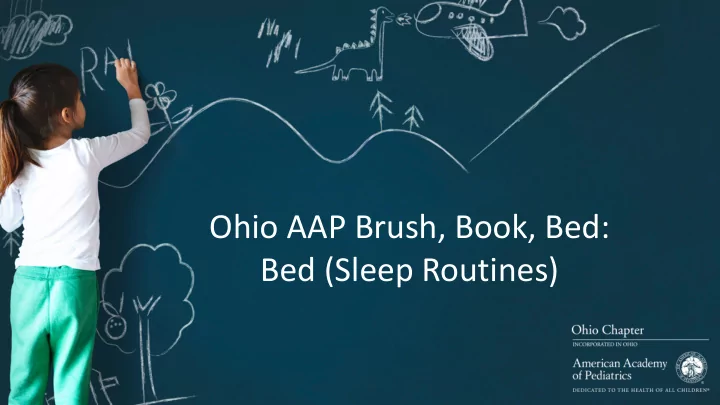

Ohio AAP Brush, Book, Bed: Bed (Sleep Routines)
CME Disclaimer I have no personal financial relationships in any commercial interest related to this CME. I do not plan to reference off label/unapproved uses of drugs or devices. James Duffee, MD, MPH james.duffee@wright.edu
Learning Objectives • Promote positive oral health routines with patients beginning at 6 months of age • Understand and implement fluoride varnish procedures • Discuss early literacy with families during pediatric well visits and other encounters • Improve knowledge of appropriate sleep habits and advise patients with sleep related concerns
The Power of Routine • Make daytime playtime. Talking and playing with your baby during the day will help lengthen her awake times. This will help her sleep for longer periods during the night. • The power of a bedtime routine is not in what you do, but how you do it . Start following a set pattern every night (e.g. bath, tooth brushing, quiet activity - story/song) for about 30 minutes starting at the same time. • Start early enough in the evening so you have time to get through the sequence before bedtime. • You can start your ritual in the bathroom or the living room; it should end in your baby's bedroom.
Bedtime: Infants • Put your baby to bed when drowsy but still awake. This will help your baby learn to fall asleep on her own in her own bed. • Keep your baby calm and quiet when you feed or change her during the night. Try not to stimulate or wake her too much • Safe sleep • SIDS and Other Sleep-Related Infant Deaths: Updated 2016 Recommendations for a Safe Infant Sleeping Environment https://pediatrics.aappublications.org/content/pediatrics/138/5/e20162938.full.pdf
Bedtime fussiness • Wait a few minutes before responding to your child’s fussing. See if she can fall back to sleep on her own. If she continues to cry, check on her, but don’t turn on the light, play with her, or pick her up. If she gets frantic or is unable to settle herself, consider what else might be bothering her. She may be hungry, wet or soiled, feverish, or otherwise not feeling well. • If night waking occurs, reassure briefly, give stuffed animal or blanket for self- consolation (before age one, stuffed animals and blankets should not be placed in the bed with the child for risk of suffocation) and bring back to bed.
Toddler Bedtime Struggles • Set up a quiet routine before bedtime • Be consistent. • Allow your child to take a favorite thing to bed each night. • Make sure your child is comfortable. • Do not let your child sleep in the same bed with you. • Do not return to your child's room every time he complains or calls out. Wait several seconds before answering and make your response time longer each time he calls. This will give him a • chance to fall asleep on his own. Reassure your child that you are there. If you need to go into the room, do not turn on the light, play with him, or stay • too long. Move farther from your child's bed every time you go in, until you can reassure him verbally without entering his • room. • Remind him each time he calls that it's time to go to sleep. • Give it time. • https://www.healthychildren.org/English/healthy-living/sleep/Pages/default.aspx
Sleep Disorders in ADHD and ASD • Bidirectional relationship between sleep disorders and daytime behavior • Sleep hygiene and behavioral interventions “cornerstone of management” • Good sleep hygiene involves daytime and evening routines as well as optimal sleep environments • Limit exposure to TV and computer screens for at least an hour before bed • Ensuring a consistent bedtime routine with as little night to night variability as possible • Effective routines improve sleep and decrease parental stress • Singh K Zimmerman AW. Sleep in Autism Spectrum Disorder and Attention Deficit Hyperactivity Disorder. Semin Pediatr Neurol . 2015; 22:113-125
http://ohioaap.org/brushbookbed
Recommend
More recommend